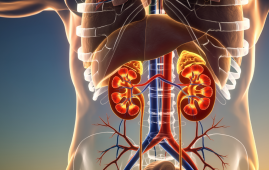

Researchers looked at relationships between metabolic syndrome (MetS) and neuroimaging and cognitive outcomes in dementia-free adults in a new study that was published in Diabetes Care.
Context
Vascular and cardiometabolic risk factors make MetS a serious public health concern. It impacts one-fourth of adult people worldwide.
One of the following characteristics is typically used to diagnose metabolic syndrome: 1) increased triglycerides, blood pressure, and glucose; 2) decreased high-density lipoprotein (HDL) cholesterol; or 3) increased waist circumference.
Given that MetS is a modifiable risk factor for cardiovascular and cerebrovascular disorders, disease prevention strategies may find it appealing to target this variable. In addition, it is anticipated that the incidence of dementia will triple over the next three decades due to global increases.
MetS has recently been associated with an increased risk of dementia. A variety of cognitive and neuroimaging tests can identify potential brain health issues.
Each of the traditional cardiovascular and metabolic risk factors—obesity, hyperlipidemia, hypertension, diabetes, etc.—has been independently associated with a lower quality of brain function. According to a meta-analysis, MetS was linked to worse performance on cognitive tests.
MetS has been evaluated in connection with either neuroimaging or cognition, although the majority of the research that has looked at both has been restricted to certain populations.
Concerning the study
The current investigation looked at relationships between MetS and results from cognitive and neuroimaging tests. They made use of information from the UK Biobank.
In 2006–10 (the baseline year), participants completed physical exams and filled out questionnaires with information on lifestyle, health, environmental, and sociodemographic aspects. At baseline, blood samples were also taken to evaluate biomarkers.
The subjects were asked to return for additional imaging evaluations. During the follow-up, cognitive tests were administered and baseline measurements were repeated, except for biomarker data.
Fluid intelligence tests, trail-making tests A and B, symbol-digit substitution tests, backward digit span tasks, matrix pattern completion tests, and paired associate learning tasks were among the cognitive assessments. MetS and reference (no MetS) groups were created from the participants.
Abdominal obesity, increased blood pressure, high triglycerides, decreased HDL cholesterol, and elevated fasting blood glucose were the minimum three criteria that were considered to be present in Metabolic Syndrome (MetS).
Individuals suffering from dementia, long-term neurodegenerative diseases, aneurysms, encephalitis, stroke, nervous system infection, cerebral palsy, brain hemorrhage, brain cancer, brain abscess, or Parkinson’s disease were not included in the team.
Phenomena generated from imaging were chosen according to how well they corresponded with measures of brain health. Covariate adjustments were made to multivariable linear regression models, which looked at relationships between MetS and outcomes.
Apolipoprotein E (APOE)-ε4 carrier status, alcohol use, smoking status, physical activity, education, household income, sex, age, and the Townsend deprivation index were among the covariates.
Results
There were 37,395 individuals in all, and 7,945 of them had MetS. Males, older White people, smokers in the past, less physically active people, APOE-ε4 carriers, lower family income, lower levels of education, and living in socioeconomically challenged locations were all more common characteristics of the MetS group.
Six percent of MetS participants had all five components, whereas 65.7% of MetS subjects had three MetS components. The most common factor was high blood pressure.
In comparison to no MetS, MetS was linked to decreased quantities of gray matter, the entire brain, and the (left and right) hippocampal regions, as well as higher volumes of white matter hyperintensity (WMH). White matter volume and MetS did not significantly correlate.
The researchers also discovered a dose-response association between multiple neuroimaging measurements and the quantity of MetS components present.
Reduced gray matter and total brain sizes were substantially correlated with higher waist circumference and elevated glycated hemoglobin (HbA1c), among other components. In contrast, there is a substantial correlation between greater WMH volume and rising blood pressure.
Similarly, sex and MetS interacted significantly with white matter, gray matter, and total brain sizes; in men, this relationship was more robust. Cognitive testing revealed significantly lower performance in MetS individuals. There was shown to be a dose-response association between cognitive function and the quantity of MetS components present.
Significantly lower individual component cognitive performance was linked to elevated blood pressure. Age did not interact with MetS or cognitive results; however, there was a clear and substantial interaction between sex and MetS and verbal and numerical reasoning, with a larger correlation in males.
In conclusion
MetS was linked to reduced brain volume, increased vascular disease, and impaired cognitive function. Increases in MetS components were associated with reduced brain volume, vascular disease, and worse cognitive function in a dose-response relationship.
These findings point to a relationship between MetS and worsening overall brain health as opposed to effects that are domain- or region-specific. Future studies should assess if MetS enhancements could improve brain function.
For more information: Association of Metabolic Syndrome With Neuroimaging and Cognitive Outcomes in the UK Biobank, Diabetes Care, https://doi.org/10.2337/dc24-0537
more recommended stories
 Pelvic Floor Disorders: Treatable Yet Often Ignored
Pelvic Floor Disorders: Treatable Yet Often IgnoredKey Takeaways (Quick Summary) Pelvic floor.
 Urine-Based microRNA Aging Clock Predicts Biological Age
Urine-Based microRNA Aging Clock Predicts Biological AgeKey Takeaways (Quick Summary) Researchers developed.
 Circadian Control of Neutrophils in Myocardial Infarction
Circadian Control of Neutrophils in Myocardial InfarctionKey Takeaways for HCPs Neutrophil activity.
 E-Cigarette Use and Heart Attack Risk in Former Smokers
E-Cigarette Use and Heart Attack Risk in Former SmokersKey Takeaways for Clinicians and Nurses.
 36-Week Pre-eclampsia Screening May Reduce Term Risk
36-Week Pre-eclampsia Screening May Reduce Term RiskA New Preventive Strategy for Term.
 Cardiovascular Risk and Sudden Cardiac Death in Diabetes
Cardiovascular Risk and Sudden Cardiac Death in DiabetesRising Sudden Cardiac Death (SCD) Risk.
 Poor Kidney Function and Alzheimer’s Biomarkers Explained
Poor Kidney Function and Alzheimer’s Biomarkers ExplainedPoor kidney function may influence levels.
 Walking Speed Before Hip Replacement Predicts Recovery
Walking Speed Before Hip Replacement Predicts RecoveryNew Evidence Points to a Simple,.
 Neuroblastoma Drug Combo Extends Survival in Models
Neuroblastoma Drug Combo Extends Survival in ModelsA Promising Shift in High-Risk Neuroblastoma.
 How Soybean Oil Impacts Weight Gain and Metabolism
How Soybean Oil Impacts Weight Gain and MetabolismWhy Soybean Oil May Affect Metabolism.

Leave a Comment